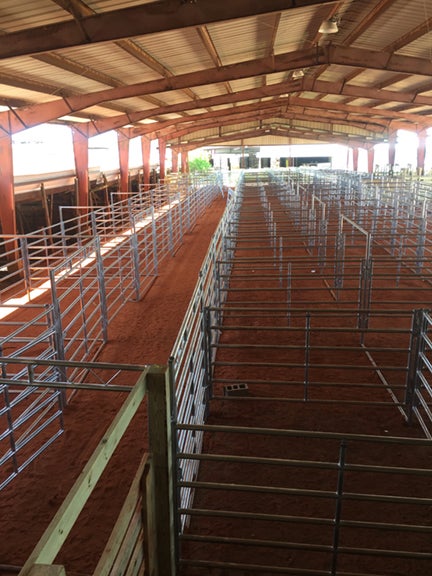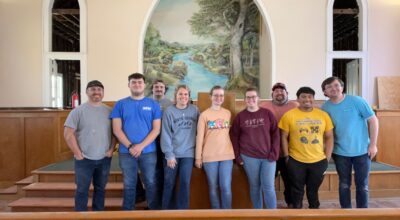Sumter County Stockyard reopens
Published 1:30 pm Saturday, May 5, 2018

- The newly-renovated pens in which the cattle are held at the Sumter County Stockyard.
By Ken Gustafson
AMERICUS – The Sumter County Stockyard, which has been undergoing renovations for the past two months, was open and ready for business on April 30, according to Dr. LeAnna Wilder, who works at the Macon County Veterinary Hospital and is new president and CEO of the Sumter County Stockyard LLC, the company that is running the stockyard.
There was an 11 a.m. luncheon on April 30, followed by the first sale of cattle at 1 p.m. According to Wilder, there will also be a grand opening on Monday, May 7 with a luncheon at 11 a.m., followed by the first sale of the day at 1 p.m. The stockyard is located at 505 Southerfield Road in Americus. Georgia Commissioners of Agriculture, Gary Black, along with other dignitaries are scheduled to attend.
Wilder was excited about the re-opening of the Sumter County Stockyard, and the boost in the economy that it will bring to the citizens of Sumter County. “It will benefit the tax payers, especially the cattle owners,” Wilder said. “They will have a local barn to bring their cattle to sell their cattle. They can minimize hauling fees and shrinkage on their cattle and get more for them. It will also bring business into the city and into the county for gas purposes, feed for farmers feed and seed, and possibly even hotels, so we’re hoping to stimulate economy. We’re also going to provide probably around 20 jobs in the area, and most of those are coming from right here in Sumter County.”
According to Wilder, the Sumter County Stockyard Authority used to run the facility. “The county has always owned the facility,” Wilder said. “Bobby Gooden and the Livestock Authority ran the barn for, I’d say, 10 years or so.” Wilder said Gooden and his staff did the best they could with what they had to work with. “The facility was a little bit dilapidated,” Wilder said. “The cow numbers were maybe down a little bit low. Cow prices dropped to drastic lows, so that probably hurt this business the most.”
According to Wilder, many changes to the stockyard facility have been made. She said that the ring area has been completely torn down and rebuilt, and that the building has been completely demolished and
redone. “The only thing that’s standing that’s the same is the actual ring itself,” Wilder said. She saud that in the holding pin area, new boards have been put in, new loading shoots have been installed, and new load-in shoots and load-out shoots. There is a new tagging facility. There’s a hydraulic shoot in the back to do pregnancy checks and other veterinary work they may need to be done to the cows that come in.
The last sale that took place at this facility prior to reopening, was Feb. 1, 2017. After that, the facility closed its doors for renovations. Wilder said that the Sumter County Stockyard LLC has only been in business for a few weeks, but that she has been working with the Sumter County Board of Commissioners for much longer than that as far as getting the leasing finalized. “I’ve been talking to the county commissioners for about a year and a half,” Wilder said. She runs the Macon County Veterinary Hospital in Montezuma. “I’m a large-animal veterinarian,” Wilder said. “When the Livestock Authority told the county commissioners it was going to close, they approached me and wanted me to run it. This facility belongs to the county, but they needed a manager, so they approached me and I declined several times, but after a lot of persistence from Mr. Randy Howard (chairman of the Sumter County Board of Commissioners), I accepted and they started working on the barn. The barn could not sustain the way it was. It was a hazard.” She said there was termite damage and that the pens were falling down. “It was kind of dangerous to be back in here in the area,” Wilder said.
Wilder said she believes that as a livestock business, to run the new and refurbished Sumter County Stockyard, they will need to bring in $20,000 to $30,000 a month. “We’ll bring in more. We can bring in as much as $300,000 to $500,000,” Wilder said. “To actually run the place, pay for utilities, pay the employees, we probably need to gross about $20,000 a month.”
Wilder said that she, along with her Associate Manger Sam Steele, will manage the facility. “We have probably, as of right now, about 10 employees and we’re looking to hire about five more,” Wilder said. “They range anywhere from 20 years old to 60 years old, so it’s a wide range of ages with employment”
According to Wilder, the sale of cattle will take place every week on Sundays and Mondays. The Sunday schedule will be 1-6 p.m. The sale of cattle on Mondays will be an all-day thing from early in the morning starting at 7 a.m. until the last cow is sold. Wilder expects that the last sale on Mondays to be about 9 or 10 p.m. “It depends on how quickly it goes and how many people we have,” Wilder said.
During the rest of the week, if there are any cattle left over, they will feed and water the cattle and get them ready for the next sale, as well as cleaning up and maintaining the facility.
According to Wilder, in the livestock business, the market varies from week to week. For example, she said that on average, a 500-lb. steer calf will bring the seller roughly $700, but that can fluctuate. “A breed cow may bring you $1,200 to $1,300,” Wilder said. “Of course, as a farmer, you want to buy when the prices are low and sell when the prices are high, so it just depends. You can get your cattle from various places. You can buy them off the farm. You can come here to the stockyard and buy them. Hopefully what we would do when a farmer would buy a pregnant cow for, let’s say, $1,200. That’s what it would roughly cost for a commercial-type cow. It would have a calf. They would sell that calf for $700 roughly when it was old enough to be weaned. As she has three to four cows in her lifetime, then that farmer gets his money. That’s how the farmer makes his money: by selling calves off of that.”
Wilder said there are all kinds of aspects of the cattle industry. “We have people who come in that just want to buy the 500 or 600-weight calves and they take them to the feed yard and they feed them out and they go into our food chain. There’s all kinds of different aspects of the industry.”
Wilder said that they have contacted people in at least 20 counties around the area, so the facility will serve more than just Sumter County. According to Sumter County administrator, Bill Twomey, when the Sumter County Stockyard Authority ran the facility, it served 37 Georgia counties, as well as parts of Alabama. According to Wilder, the stockyard has contacted farmers in Eufaula, Ala. “We’ve been as far as Macon. We’ve been south down to Ashburn. That would be our limit because they have a livestock barn there in Ashburn, so we wouldn’t go much further than that,” Wilder said. She said they go over to Cordele and into Dooly County as well. They have been trying to let people know that they’ve reopened and that they can bring their cattle to the Sumter County Stockyard.
Wilder said that most of cattle that will be brought to the stockyard will have an Angus background. “We see a lot of Simmental influence,” Wilder said. “We do see some Brahma cattle and Hereford … not many Longhorns, maybe a few. We will hopefully see some Holsteins. Those would be mostly from your local dairies.” According to Wilder, they are thinking about having a dairy sale in the future and actually selling bread Holsteins and young Holstein cows. “As for right now, it’s going to be pretty much mostly beef,” Wilder said.
Wilder is hopeful that the stockyard will bring in about $250,000 to $500,00 in net sales every week, but knowing that the market varies from week to week, she understands that may not always happen.
Wilder went on to explain how both the farmers and the stockyard make their money. “If you sell 300 cows at $1,000 a piece, that’s $300,000,” Wilder said. “A lot of that money has to go back to the sellers. The stockyard gets a four percent commission, and that’s where we make our money. That’s how we pay our bills. For example, four percent of $300,000 is $12,000. We charge a commission to sell the cattle. If the calf may sell for $200, we get four percent of that.”
Wilder exaplained that of the $250,000 to $500,000 made in a week or in a day in net sales that the stockyard is hoping to make, they will only keep four percent of it. All of the money the stockyard will make is on the four percent commission that the stockyard charges the farmers to sell their cattle. The majority of the money goes back to the farmers.
The number of cows that farmers will bring to the stockyard to sell will vary. “It could be any number, but probably one to 100,” Wilder said. In addition to the number of cattle brought to the stockyard by the farmers, the prices at which the cattle are sold, according to Wilder, vary as well. “The calves that you bring to sell that are six to seven months old, you sell them by the pound,” Wilder said. She went on to say that the price is roughly $1.50 a pound, but gave an example of how the process works. “If the price is $1 a pound, and a calf ways roughly 600 lbs., you’d get $600,” Wilder said. She said the stockyard writes checks to the farmers, and within 24 hours of the sales, they should have their checks.
In addition to the expenses the stockyard must pay in utilities, pay roll, health insurance and other expenditures, Wilder added that the county charges the stockyard $2 per animal that comes through the shoot to be sold. While the stockyard needs to bring in $20,000 a month to stay operational, Wilder and her staff are obviously hoping to make more than just $20,000 a month. “It all depends on how many people bring in the cows,” Wilder said. “We are not guaranteed that we will get 100 cows a week or 500. It depends on how the sale goes and if people want to bring their cattle to us. That’s why we’re out advertising and trying to let people know that we’re open so they will have the opportunity to bring their cattle here.”
Since the stockyard closed over a year ago, according to Wilder, there has been a tremendous amount of renovation to the facility. “This place doesn’t even look the same,” Wilder said. “People who saw it when it closed need to come look at it now because it looks like a totally different facility. They’ve put in a lot of money, a lot of time and a lot of effort to make this place very, very nice.” Wilder said the stockyard is very people-friendly, very cow-friendly and that there is no reason why this barn shouldn’t do very well.




